MESA VERDE (Day 16 - part 4)
At Sun Point View, we could look down the length of two canyons. There are over 30 cliff dwellings that could house 600 - 800 in this area. From the years 1200 - 1300, half the population of Chapin Mesa was concentrated here. The reason is because of a reliable water supply in the form of a spring at the head of Cliff Canyon.


The view straight ahead at the canyon junction: Sun Temple, Mummy House, Cliff Palace
For over 600 years, the Puebloans lived on the mesa tops. It was only for the 75 - 100 years that they lived in the cliff dwellings. Of the 4,000 ruins within the park, only 600 are cliff dwellings.

Sun Temple

Mummy House

Cliff Palace
How do these giant alcoves form? Seep springs create areas in the rock where water accumulates for thousands of years. The freezing/thawing process eventually causes fractures in the sandstone. Chunks of the cliff wall finally weaken and break off, leaving the alcoves to weather and grow over time.

More Cliff Palace
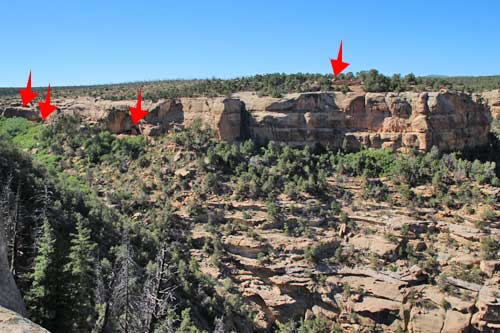
The view to the left down Fewkes Canyon (named after Dr. Jesse Walter Fewkes who led excavations in the early 1900's): Fire Temple, New Fire House, Oak Tree House, Sun Temple
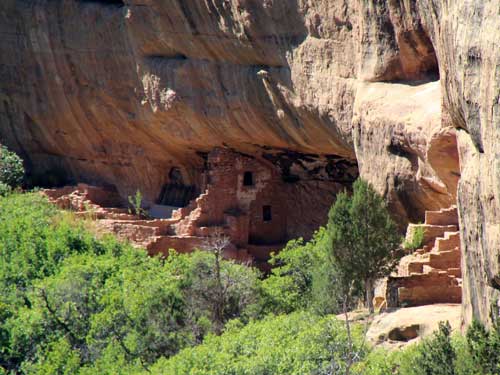
Fire Temple (left) and New Fire House

Oak Tree House

The view to the right across Cliff Canyon: Cliff Palace, remnants of a 20 room dwelling, village of 15 rooms

Remnants of a 20 room dwelling

Village of 15 rooms

View down Cliff Canyon: village of 15 rooms, Sunset House, overlook spot

Sunset House

Could you imagine climbing down from this overlook to one of the dwellings below??
The Oak Tree House was constructed around 1250. To adapt to a sloping alcove floor, the people filled in a retaining wall. The altered floor not only supported the rooms but also provided ample space for work or children playing.


The house contains about 50 rooms and 6 kivas. There are additional storage rooms along the upper ledge. Rooms were intended for different uses: living, storage, public gatherings, ceremonial, lookouts, etc.


A closer view of Fire Temple and New Fire House
Sun Temple was built in 1250. This mesa-top structure is different than most buildings. It was obviously a massive undertaking but its function is unclear. It followed a preconceived design, was very finely constructed, has no doors or windows or firepits, had geometric designs and possibly solar markers, and there is no evidence of a roof (but perhaps that is because it was never finished).

The layout
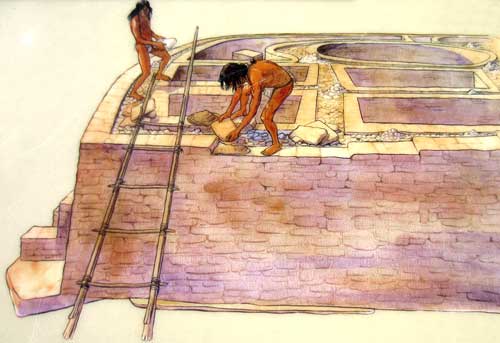
The 4-foot thick walls were double lined and filled with rubble.

No way in



Just next to the temple was another overlook for Cliff Palace, the park's largest cliff dwelling. Discovered in 1888 by two cowboys, Richard Wetherill and Charlie Mason, the dwelling was home from anywhere from 80 to 300 people.
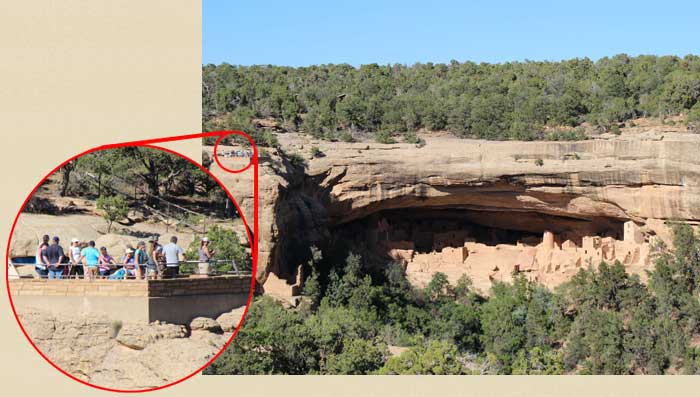

The palace had 150 rooms, square and round towers, and 22 kivas. People lived here from 1200 - 1275.
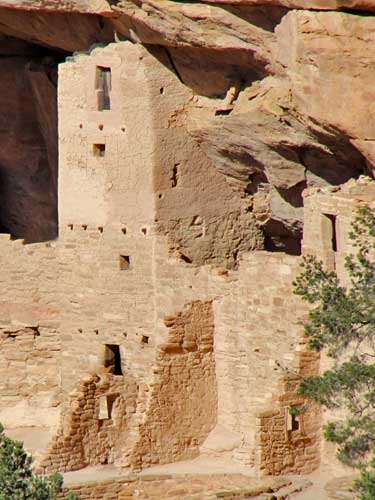


We then visited the Spruce Tree House. This was the easiest of all the dwellings to actually visit... unfortunately it was closed due to rockfall. So we at least tried to admire it from afar.
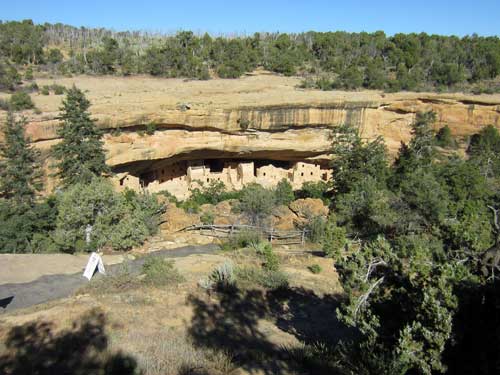


This is the third largest and best preserved dwelling in the park. Early explores named it after the towering Douglas fir trees (historically referred to as spruce trees) found in the canyon below.
With over 120 rooms, 10 ledge rooms, 8 kivas and two towers, the dwelling was built over the span of time from 1200 to 1278. Peak population was 60 - 90 people.


These odd pieces embedded in the rock aren't old pieces of pipe or metal. They are naturally occurring concretions of iron oxide and/or calcium carbonate. They were deposited as mineralized water moved through the sandstone, sometimes encasing pebbles or filling small voids.


In the Southwest, it isn't uncommon to look up and see vultures slowly circling overhead. But what do you call a group of vultures? Apparently while in flight it's a kettle of vultures; when resting in the trees it's either a committee, volt or venue; and while feeding it's a wake!
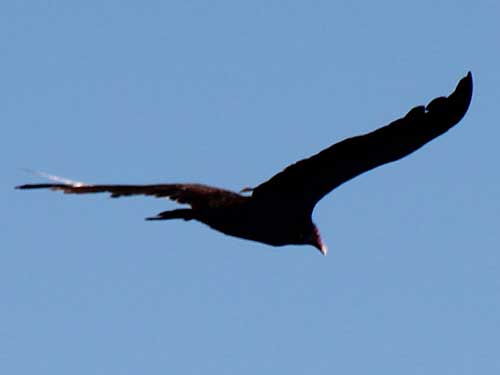
The Turkey Vulture is the most widespread of the New World vultures.
Next to the Spruce Tree House was the Chapin Mesa Archeological Museum. We enjoyed the numerous displays and were able to catch the last movie of the day.

The old park headquarters buildings from 1922 - 1938 (which contain the museum) are done in the Modified Pueblo Revival style.


A highlight of the museum were the dioramas. Each scene is based on a real-life location and depicts various aspects of daily life... work, play, laziness, humor.
Built primarily by the CCC (Civilian Conservation Corp) in the 1930's during the Great Depression, the diorama provided them with a world far away from the harsh realities of the time. Here in their miniature world, people were happy, had enough to eat and didn't worry about money. The dioramas were completed in 1939 and were so popular that the glass had to be cleaned from smudge marks and nose prints every few hours.

Constructing a frame
Initial sketches were made and small-scale samples were built. Then frames were constructed and the miniature work could begin. Every detail was carefully crafted by hand and workers had to experiment with different materials to determine what worked best. Newspaper was soaked in water for several weeks and then run through a meat-grinder to give it the texture of rocks.

Creating the people

For human figures, wire frames were covered with cotton. The forms were placed in molds filled with a mixture of beeswax and balsam resin. They were then bent into position before they dried completely.

Scene 1: Early habitation in North America - 10,000 to 15,000 years ago
People began crossing the Bering Strait from Asia at least 15,00 years ago. They migrated south, following the elephants, mammoths, camels and bison.
Archeologists found 19 fluted spear points among the bones of 30 bison at this site near Folsom, New Mexico from a hunt that took place 10,000 years ago. Hunters often killed the bison at a water hole. They would skin the animals, take the flesh they needed and leave the rest. Deeply embedded points were not retrieved, thus providing us with a record. No such evidence has been found yet at Mesa Verde.

Sneaking up on their prey. Everything had such fine detail! Note the flower cactus plants in the background.

The hunters may have used a spear thrower called an atlatl (shown here).
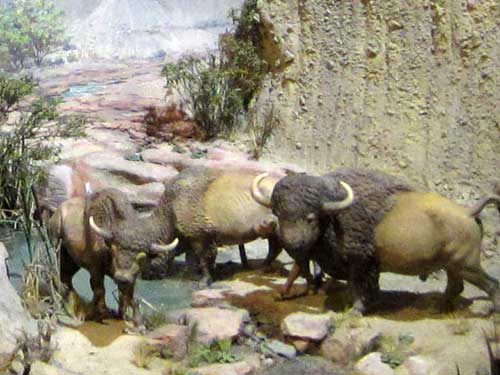
The Folsom bison is now extinct. They were larger than today's bison.
return • continue

